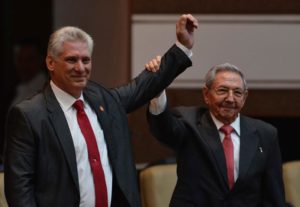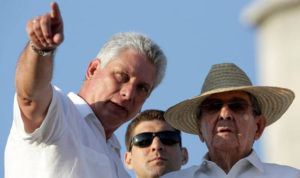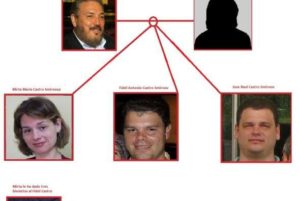 (OPINION) THE CASTRO’S DESCENDANTS: HEIRS OF THE DYNASTY?.(PHOTOS).
(OPINION) THE CASTRO’S DESCENDANTS: HEIRS OF THE DYNASTY?.(PHOTOS).
This week, Cuba entered a new, post-Castro era. For 60 years, the country had been directly led by two members of one family.
After Fidel stepped down, his younger brother and loyal ally, Raúl, took over. On Thursday, the 86-year-old Raúl Castro stepped down as the head of Cuba’s Council of State, a position that effectively serves as Cuba’s president. There was only one candidate offered to succeed him: Miguel Díaz-Canel, a 58-year-old non-Castro civilian.
Is this the end of the dynasty that has controlled Cuba for decades? Probably not. Many critics contend that Raúl, who will remain as head of the Communist Party until his term ends in 2021, would keep the real power for himself. It is notable the next generation of the dynasty — the Castro kids — are not officially taking hold of the reins.
Raúl Castro had the option of choosing his successor — he had openly described Díaz-Canel as handpicked Thursday. “His election is not by chance,” Castro said. But Raúl did not choose a Castro, even though there were plenty from which to choose: Although details about the extended family were once kept quiet, it is now believed Fidel had 11 children, while Raúl himself had four.
Fidel’s only son from his first marriage, also named Fidel but popularly known by the diminutive Fidelito, was once in charge of Cuba’s nuclear program. He was removed from many government positions in 1992 after falling out with his father, who reportedly accused him of “incompetence”; he killed himself early this year.
Another high-profile child was Alina Fernández Revuelta, the product of an affair between Fidel and a Cuban socialite, who fled Cuba in 1993 and became a vocal critic of the Cuban government. Of Fidel’s known children from his second wife, most seemed to avoid the limelight: One son, Alex, was a state photographer; another, Antonio, worked with the Cuban Baseball Federation; and another, Alejandro, was once reported to be a computer scientist. None appears to have held political ambitions.
Raúl’s children are more politically minded. One daughter, Mariela Castro Espín, is a prominent campaigner for AIDS prevention and LGBT rights, and a member of Cuba’s National Assembly. Her brother, Alejandro Castro Espín, runs Cuba’s counterintelligence services and helped secretly negotiate with the Obama administration. Also of note is Gen. Luis Alberto Rodríguez López-Callejas, formerly Raúl’s son-in-law, who has a powerful position running the business arm of the Cuban military.
This younger generation may well come to play a role behind the scenes in Cuba. However, the Castro family also has a history of political division: Fidel and Raúl’s sister, Juanita Castro, defected from Cuba in 1964 after collaborating with the Central Intelligence Agency. The family of Fidel Castro’s first wife, Mirta Diaz-Balart, have become prominent U.S.-based critics of the Castro regime.
As he passed the presidency over to Díaz-Canel, Raúl Castro emphasized that continuation as a theme of the changeover of power. Díaz-Canel himself said he would bring “continuity to the Cuban revolution” and change in the context of Cuban socialism. With a reputation as a consensus-builder, he is expected to largely follow the cautious reforms of Raúl Castro. If the current plan holds, Díaz-Canel will hold a powerful position in Cuban politics until 2031; first as president for two terms, then as Communist Party leader for two terms.
Such a change may be in keeping with what Fidel Castro would have wanted, too. When Fidelito was removed from his government position in 1992, Fidel reportedly told a journalist: “What’s the problem? We don’t have a monarchy here.”
 LOS DESCENDIENTES DE LOS CASTRO: HEREDEROS DE LA DINASTÍA?
LOS DESCENDIENTES DE LOS CASTRO: HEREDEROS DE LA DINASTÍA?
Esta semana, Cuba entró en una nueva era post Castro. Durante 60 años, el país había sido dirigido directamente por dos miembros de una familia.
Después de que Fidel renunció, su hermano menor y leal aliado, Raúl, se hizo cargo. El jueves, Raúl Castro, de 86 años, renunció como jefe del Consejo de Estado cubano, un cargo que efectivamente sirve como presidente de Cuba. Solo se le ofreció un candidato para sucederlo: Miguel Díaz-Canel, un civil no castrista de 58 años.
¿Es este el final de la dinastía que ha controlado Cuba durante décadas? Probablemente no. Muchos críticos sostienen que Raúl, quien permanecerá como jefe del Partido Comunista hasta que termine su mandato en 2021, mantendría el verdadero poder para sí mismo. Es notable que la próxima generación de la dinastía, los niños de Castro, no asuman oficialmente las riendas.
Raúl Castro tenía la opción de elegir a su sucesor; había descrito abiertamente a Díaz-Canel como elegido el jueves. “Su elección no es por casualidad”, dijo Castro. Pero Raúl no eligió un Castro, a pesar de que había muchos para elegir: aunque los detalles sobre la familia extensa se callaron una vez, ahora se cree que Fidel tuvo 11 hijos, mientras que el propio Raúl tuvo cuatro.
El único hijo de Fidel de su primer matrimonio, también llamado Fidel pero conocido popularmente por el diminuto Fidelito, estuvo una vez a cargo del programa nuclear de Cuba. Fue removido de muchos cargos gubernamentales en 1992 después de haberse peleado con su padre, quien según los informes lo acusó de “incompetente”; él se suicidó a principios de este año.
Otra niña de alto perfil fue Alina Fernández Revuelta, producto de un romance entre Fidel y una miembro de la comunidad cubana, que huyó de Cuba en 1993 y se convirtió en un crítico del gobierno cubano. De los hijos conocidos de Fidel de su segunda esposa, la mayoría parecía evitar el centro de atención: un hijo, Alex, era un fotógrafo estatal; otro, Antonio, trabajó con la Federación Cubana de Béisbol; y otro, Alejandro, una vez se informó que era un científico de la computación. Ninguno parece haber tenido ambiciones políticas.
Los hijos de Raúl tienen una mentalidad más política. Una hija, Mariela Castro Espín, es una importante defensora de la prevención del SIDA y los derechos LGBT, y miembro de la Asamblea Nacional de Cuba. Su hermano, Alejandro Castro Espín, dirige los servicios de contrainteligencia de Cuba y ayudó secretamente a negociar con la administración de Obama. También es de destacar el general Luis Alberto Rodríguez López-Callejas, ex yerno de Raúl, quien tiene una posición poderosa al frente del brazo empresarial del ejército cubano.
Esta generación más joven puede llegar a desempeñar un papel detrás de escena en Cuba. Sin embargo, la familia Castro también tiene una historia de división política: Fidel y la hermana de Raúl, Juanita Castro, desertaron de Cuba en 1964 después de colaborar con la Agencia Central de Inteligencia. La familia de la primera esposa de Fidel Castro, Mirta Diaz-Balart, se ha convertido en una prominente crítica del régimen de Castro con base en los Estados Unidos.
Cuando pasó la presidencia a Díaz-Canel, Raúl Castro enfatizó que la continuación era un tema del cambio de poder. El mismo Díaz-Canel dijo que traería “continuidad a la revolución cubana” y cambio en el contexto del socialismo cubano. Con una reputación como constructor de consenso, se espera que siga en gran medida las cautas reformas de Raúl Castro. Si el plan actual se mantiene, Díaz-Canel tendrá una posición poderosa en la política cubana hasta el 2031; primero como presidente por dos períodos, luego como líder del Partido Comunista por dos períodos.
Tal cambio puede estar en consonancia con lo que Fidel Castro también hubiera querido. Cuando Fidelito fue destituido de su puesto en el gobierno en 1992, según informes, Fidel le dijo a un periodista: “¿Cuál es el problema? No tenemos una monarquía aquí “.
Agencies/WashPost/Adam Taylor/Excerpts/Analisis/ Internet Photos/ Arnoldo Varona/ TheCubanHistory.com
THE CUBAN HISTORY, HOLLYWOOD.








